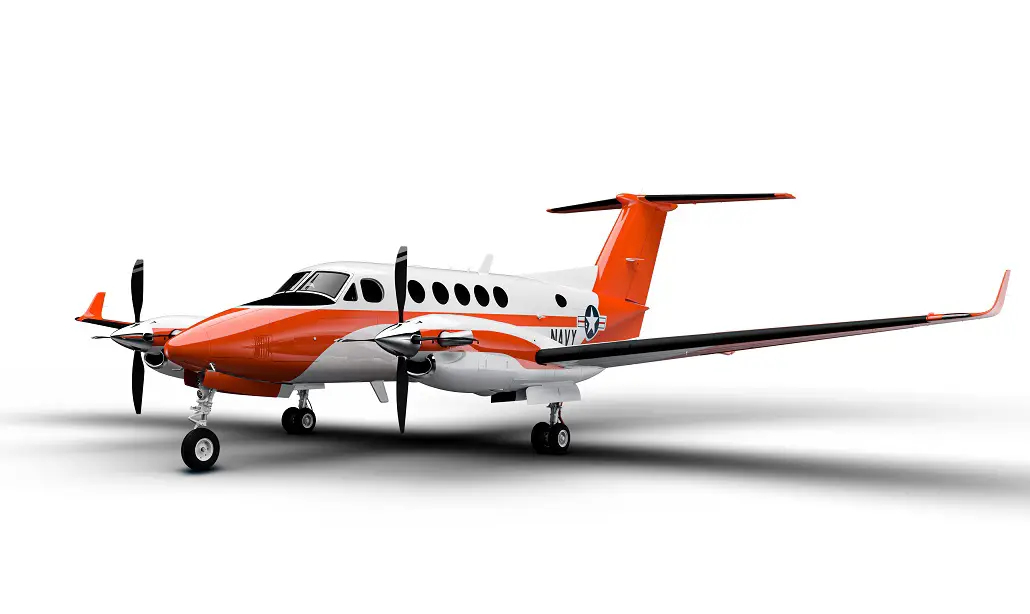Textron Aviation today announced it has been awarded the Multi-Engine Training System (METS) contract by Naval Air Systems Command (NAVAIR) through a full and open competition. The contract award is for up to 64 King Air 260 aircraft, which will be known as the T-54A. The initial Lot I award will procure 10 new Beechcraft King Air 260 commercial aircraft and associated support. Lot II and Lot III, if the options are exercised, would each procure up to 27 aircraft. Aircraft deliveries are planned from 2024 to 2026. The Beechcraft King Air 260 aircraft acquired under the METS contract will replace the Chief of Naval Air Training (CNATRA) fleet of T-44C Pegasus aircraft. The T-44C Pegasus aircraft is a variant of the twin-engine and pressurized Beechcraft King Air 90. The T-44 has been in service since 1977.
The Multi-Engine Training System (METS) specific capabilities include factory options for TACAN (Air to Air), angle of attack (AOA), V/UHF radio, digital audio system, engine trend monitoring, condition based maintenance plus, observer/jump seat, passenger mission seats, and full-face oxygen masks. The King Air 260 METS aircraft will be delivered in a fully compliant, METS mission ready configuration from Textron Aviation’s King Air production line in Wichita, Kansas. When government, military and commercial customers want airborne solutions for critical missions, they turn to Textron Aviation. The company’s aviation solutions provide the high performance and flight characteristics required to address the unique challenges of special missions operations. With unparalleled quality, versatility and low operating costs, Textron Aviation products are preferred for air ambulance, ISR, utility transport, aerial survey, flight inspection, training and a number of other special operations.

“With its advanced technology, the new METS platform will be more representative of fleet aircraft,” said Capt. Holly Shoger, Naval Undergraduate Flight Training Systems Program Office (PMA-273) program manager. “The T-54A will include an updated avionics suite, automation qualities, and virtual reality and augmented reality devices to better prepare students for the advanced aircraft they will fly in the fleet.”
“We are honored the U.S. Navy has again selected the Beechcraft King Air to fulfill its training needs,” said Bob Gibbs, vice president, Special Missions Sales for Textron Aviation. “METS will modernize multi-engine aircraft training at CNATRA, providing an intermediate and advanced training platform for U.S. Navy, U.S. Marine Corps and U.S. Coast Guard aviators into the P-8, EP-3, KC-130, E-6, E-2, CMV-22, CV-22 and MV-22 aircraft.”
More than 7,700 Beechcraft King Air turboprops have been delivered to customers around the world since 1964, making it the best-selling business turboprop family in the world. The worldwide fleet has surpassed 62 million flight hours in its 58 years, serving roles in all branches of the U.S. military and flying both commercial and special missions roles around the world. The King Air 260 brings state-of-the art technology to the cockpit and offers greater ease of flight. The cockpit features the Innovative Solutions & Support (IS&S) ThrustSense Autothrottle system, which supports pilots in their critical mission of delivering people or cargo by automatically managing engine power from the takeoff roll through the climb, cruise, descent, landing, and go-around phases of flight. The King Air 260 cockpit also features a digital pressurization controller, which automatically schedules cabin pressurization during both climb and descent, reducing pilot workload and increasing overall passenger comfort. The pressurization gauges have been integrated with the powerful Collins Aerospace Pro Line Fusion flight deck.The aircraft includes the Collins Multi-Scan RTA-4112 weather radar, providing pilots with a fully automatic system that is optimized to detect short, mid and long-range weather















